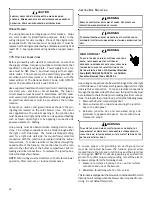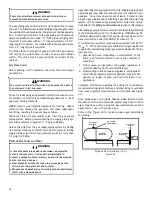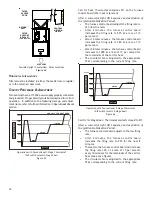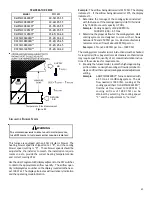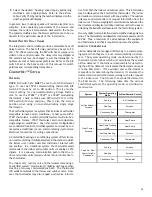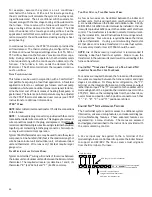
42
8. Field Test Mode is intended to help a service person
troubleshoot and check out an installed appliance
by bringing the furnace up to High fire (100% input),
by-passing the normal modulating routing.
To enter Field Test Mode the Fault Recall Push-
Button must be pressed twice within a 5 second
period at any time during a heating cycle, at which
time the display will show “Ft”. While the display
is showing “Ft”, pressing and holding the Fault
Recall Push-Button for 3 seconds will enable the field
test mode and override the normal firing rate
sequence at a rate of 100% for 5 minutes or until
the end of the call for heat. The display will show
the normal “Hi” while the control is firing at 100%.
If the Fault Recall Push-Button has not been pressed
within 5 seconds of displaying “Ft” the display will
revert back to normal.
NOTE:
Gas valve is factory set and does NOT require
any field adjustment. Do NOT attempt to adjust
valve.
9. Turn off all electrical power and gas supply to the
system.
10. Remove the manometer hose from the hose barb fitting.
11. Remove the 1/8" NPT hose barb fitting from the outlet
pressure tap. Replace the outlet pressure tap plug and
seal with a high quality thread sealer.
12. Turn on electrical power and gas supply to the system.
13. Close thermostat contacts “R” and “W1/W2” to
energize the valve.
Using an approved liquid gas leak detector solution, check
for leaks at outlet pressure tap plug. Bubbles forming indi-
cate a leak. SHUT OFF GAS AND REPAIR ALL LEAKS IMMEDI-
ATELY!
Range
Nom inal
Natural
High Stage
3.2 - 3.8" w .c.
3.5" w .c.
Propane
High Stage
9.5 - 10.5" w .c.
10.0" w .c.
Manifold Gas Pressure
Gas
G
AS
I
NPUT
R
ATE
M
EASUREMENT
(N
ATURAL
G
AS
O
NLY
)
The actual gas input rate to the furnace must never be greater
than that specified on the unit rating plate. To measure natu-
ral gas input using the gas meter, use the following proce-
dure.
1. Turn OFF the gas supply to all other gas-burning
appliances except the furnace.
2. While the furnace is operating at high fire rate, time
and record one complete revolution of the gas meter
dial measuring the smallest quantity, usually the
dial that indicates 1/2 cu. ft. per revolution. You
will use this number to calculate the quantity of
gas in cubic ft. if the furnace would consume if it
ran steadily for one hour (3600 seconds).
3. If the 1/2 cu. ft. dial was used, multiply your
number x 2.
EXAMPLE: If it took 23 seconds to complete
one revolution of the 1/2 ft. dial.
This tells us that at this rate, it would take 46
seconds to consume one cu. ft. of gas. 23 x 2 =
seonds per cu. ft.
3600 (secs in 1 hour) / 46 = 78
This tells us that in one hour, the furnace would
consume 78 cu. ft. of gas.
The typical caloric range for 1 cu. ft. of natural gas
is around 1000 BTU. Check with your gas utility, if
possible. In this example, the furnace is consum-
ing 78,000 BTUH.
NOTE:
The final manifold pressure cannot
vary by more than ± 0.3” w.c. for Natural and
+ 0.5” for LP from the specified setting.
Consult your local gas supplier if additional
input rate adjustment is required.
4. Turn ON gas to and relight all other appliances
turned off in step 1. Be certain that all
appliances are functioning properly and that all
pilot burners are operating.
T
EMPERATURE
R
ISE
Temperature rise must be within the range speci-
fied on the unit rating plate. An incorrect tempera-
ture rise may result in condensing in or overheat-
ing of the heat exchanger. An airflow and tempera-
ture rise table is provided in the Specification Sheet
applicable to your model. Determine and adjust
temperature rise as follows:
1. Operate furnace with burners firing for
approximately ten minutes. Ensure all
registers are open and all duct dampers are
in their final (fully or partially open) position.
2. Place thermometers in the return and supply
ducts as close to the furnace as possible.
Thermometers must not be influenced by
radiant heat by being able to “see” the heat
exchanger.
3. Subtract the return air temperature from the
supply air temperature to determine the air
temperature rise. Allow adequate time for
thermometer readings to stabilize.
4. Adjust temperature rise by adjusting the
circulator blower speed. Increase blower
speed to reduce temperature rise. Decrease
blower speed to increase temperature rise.
Refer to
Startup Procedure and Adjustment -
Circulator Blower Speeds
for speed changing
details.
Содержание DC97MC
Страница 63: ...63 THIS PAGE LEFT INTENTIONALLY BLANK...

